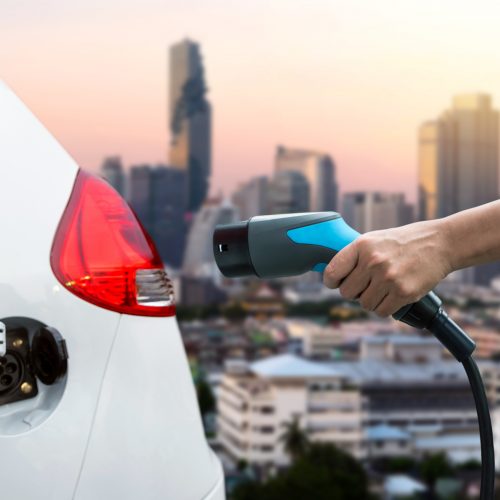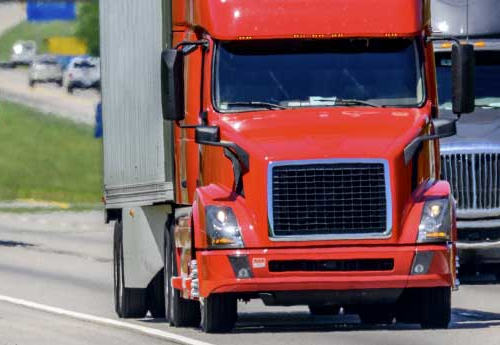
2021: The Year the Rubber Meets the Road for Electric Trucks
2021 is shaping up to be a pivotal year for the electric vehicle. While this is true across weight classes and duty cycles, perhaps none are better positioned for growth than trucks. To be sure, 2020 saw a number of exciting announcements from manufacturers eager to electrify heavy-duty big rigs, semi-trucks, box trucks, delivery vans and additional freight vehicles. And 2021 is primed to take many of these announcements from the planning stages to fruition (as our friends at GreenBiz have covered here). In many ways, 2021 is expected to be the year that electric trucks shift from demonstration to deployment.
Some key trends to watch include increasing model availability, growing political momentum in North America, declining costs, and expanded charging infrastructure and utility programs.
Increasing Model Availability
One of the top-cited challenges for trucking fleets looking to electrify, electric trucks have been hard to come by historically, with limited models available. And though it can be hard to define “production,” many manufacturers which have been developing and road-testing vehicles are slated to move into commercial production in the near future.
Over the next year, in the United States and Canada alone, zero-emissions freight vehicle availability is expected to increase from over 70 models from two dozen manufacturers to at least 85 models from over 30 companies. This includes vehicles from Arrival and Rivian, which made a splash last year after announcing large orders and partnerships with UPS and Amazon, respectively. It also includes the much-anticipated Tesla semi, which has boasted pre-orders from giants such as Walmart, PepsiCo, Anheuser-Busch, DHL, FedEx, UPS, Sysco, Loblaw, and Pride Group Enterprises. Nikola expects to begin production on their Tre battery-electric semi-truck in 2021 as well.
But it is not just these newcomers who are ramping up production of electric trucks. Traditional OEMs are getting in the game too. For example, just last month, Volvo Trucks North America announced that their Class 8 VNR Electric model will begin production in early 2021. Kenworth is also slated to produce its first Class 8 battery-electric truck—the T680E—in 2021. Meanwhile, Peterbilt—which has already begun deliveries of their Model 220EV—is slated to begin production of its new Model 579EV in Q2 and Workhorse is gearing up to start delivery of its C series panel vans in Q3 of this year.
Daimler Trucks North America (DTNA), whose president and CEO has publicly stated his belief that “the future is electric,” also plans to offer electric models in all its main sales regions by 2022. These models range from the FUSO eCanter in the light-duty segment and the Freightliner eM2 in the medium-duty segment to the Mercedes-Benz eActros and the Freightliner eCascadia in the heavy-duty segment. Daimler has also committed to carbon-neutral production, investing in a combination of energy efficiency and renewable electricity.
Finally, GM is getting in the electric delivery game via a new business unit—BrightDrop—to “electrify and improve the delivery of goods and services” via “an integrated ecosystem of electric products, software and services.” BrightDrop plans to start delivering its electric EV600 package van to its first customer, FedEx, later this year.
Growing Political Momentum in North America
Against this backdrop of increased model availability, policymakers at all levels of government are calling for an urgent transition to zero-emissions vehicles. Again, this is true across vehicle classes, although the call to address emissions from medium- and heavy-duty vehicles has seen unprecedented momentum recently as the public health impacts of these vehicles have been highlighted by the COVID-19 pandemic. Additionally, US policymakers and regulators are realizing the difficulty of achieving their ambitious climate targets without addressing pollution from this sector, which accounts for nearly one-quarter of the country’s transportation greenhouse gas emissions.
For example, in June of last year, California’s Air Resources Board (CARB) mandated via its innovative Advanced Clean Trucks (ACT) rule that commercial truck manufacturers sell zero-emissions trucks as an increasing percentage of their annual statewide sales. While the rule doesn’t go into effect until 2024, it sends a clear signal to the industry that electric trucks are coming. CARB is also developing a complementary medium- and heavy-duty zero-emissions fleet regulation.
In a show of growing political will, the following month, fifteen states and the District of Columbia – a group collectively accounting for nearly 40 percent of goods moved by truck – signed a “Multi-State Medium- and Heavy-Duty Zero Emission Vehicle Memorandum of Understanding” (MOU). This MOU commits to develop an action plan to “support widespread electrification of medium- and heavy-duty vehicles”.
Facilitated by Northeast States for Coordinated Air Use Management (NESCAUM), the MOU includes a goal of 100% zero-emissions vehicle sales by mid-century and an interim goal of 30% sales by 2030. It also includes a commitment to ensure electric truck deployments “benefit disadvantaged communities that have been historically burdened with higher levels of air pollution.” The draft action plan will be released later this year.
And states aren’t the only ones moving full steam ahead; cities are also doing their part to accelerate electric truck deployments. For example, this past year, Santa Monica, California announced plans for the country’s first zero-emissions delivery zone and New York City launched its Clean Trucks Program. Meanwhile, Chicago developed its Commercial Electric Vehicle Readiness Guidelines to help developers incorporate EV charging readiness for medium- and heavy-duty fleets into projects.
2021 may prove to be a big year for federal action as well. President-Elect Joe Biden’s climate and “Made in America” plans include massive federal support for EVs and their requisite charging infrastructure. And the incoming secretary of transportation, Pete Buttigieg, recently called for putting “millions of new electric vehicles on America’s roads” to help meet the climate crisis.
With a new climate-friendly administration, both nonprofits and industry are calling for federal action to accelerate this transition to EVs. Perhaps most notably, a group of America’s biggest truck equipment manufacturers, suppliers, and key stakeholders formed the National Zero-Emission Truck Coalition and called for a national point-of-sale incentive program to support the production and deployment of zero-emissions trucks. This idea has also been incorporated into the House Select Committee’s Climate Action Plan.
California’s ACT rule alone is expected to save the industry $7 billion, reduce emissions by more than 17 million metric tons of carbon dioxide and 60,000 tons of hazardous nitrogen oxides, prevent more than 900 premature deaths, and benefit public health to the tune of at least $9 billion over the next 20 years. Considering these broad benefits of truck electrification, political momentum behind supporting and accelerating this transition is expected to continue.
Declining Costs
The higher initial purchase price of electric trucks has also been identified by fleets as a top barrier. Fortunately, prices are expected to come down as manufacturers scale production. Prices are also expected to decrease along with battery prices, which have already declined 89% in the last decade and are expected to continue to fall.
For example, BloombergNEF’s annual Battery Price Survey found that lithium-ion battery pack prices fell 13% in the last year alone. BNEF anticipates this price will continue to drop on pace to help EVs achieve price parity with internal combustion engine vehicles within the next three years globally. In the meantime, subsidies and incentives will help fill the gap.
Expanded Charging Infrastructure and Utility Programs
Finally, utilities are slowly but surely figuring out how to partner with fleets to appropriately build out charging infrastructure to support these electric trucks. Make-ready infrastructure programs—which provide funding for required infrastructure upgrades like new transformers, conduit, panels, and meters —are now available in a handful of states. Rate design is also evolving to help ensure that clean electricity is cost-competitive with traditional diesel fuel. And infrastructure engineering, permitting, and procurement processes are being developed and streamlined. Meanwhile, issues around high-power charging (required by limited dwell time of vehicles), managed or “smart” charging, and interoperability are also being addressed.
And while the majority of early electric truck deployments currently rely on private charging infrastructure, plans are being developed to build-out accessible public charging. For example, the West Coast Clean Transit Corridor Initiative—a collaboration among electric utilities and agencies representing municipal utilities––proposed a plan to build out charging infrastructure along 1,300 miles of I-5 to support medium- and heavy-duty electric trucks from the Mexican to the Canadian border. And DTNA is partnering with Portland General Electric to open “Electric Island,” a large public charging site for medium- and heavy-duty electric commercial vehicles expected to be the first of its kind in the United States.
The Need for Real-World Data
All these trends indicate that 2021 will be a year like no other for electric trucks. But as fleets, OEMS, utilities, charging providers, and policymakers strive to shift from demonstrations to large-scale commercial deployments, the importance of leveraging real-world data and insights to address challenges and inform future deployments cannot be overstated.
To accelerate progress, the industry will need to glean lessons learned from leaders on the forefront of innovation. They will need to scale best practices while also increasing confidence that—when the rubber meets the road—these vehicles are capable of meeting the rigorous requirements of the freight industry. Most importantly, the industry will need to come together with stakeholders across the electric truck ecosystem to support innovation, collaboration, and the acceleration of zero-emissions goods movement.
In response to these needs, Rocky Mountain Institute (RMI) and the North American Council for Freight Efficiency (NACFE) today announced the third in their bi-annual Run on Less trucking demonstration series. This year’s Run on Less will focus on electric trucking, with 10 dedicated trucks and drivers reporting real-time data to show the current state of electric trucking technology in the freight industry.
Supported by title sponsors including Dana, Meritor, and Shell, the Run on Less—Electric (RoL-E) demonstration vehicles will include electric vans, medium-duty box trucks, and heavy-duty trucks moving freight in a variety of conditions and geographic areas. In order to increase electric truck adoption and deployment, RoL-E will help fleets, charging infrastructure companies, utility companies, and policymakers better understand the current benefits and challenges of hauling freight with electric trucks.
To complement the RoL-E demonstration and data collection components, RMI and NACFE will also host a series of virtual educational events (E-series) to convene industry stakeholders to discuss the why and how of electric truck deployments. An opportunity to learn from leaders in fleet electrification beyond the formal Run participants, the public E-series will include discussions with fleet managers, charging providers, utilities, engineering firms, policymakers, and more.
RMI and NACFE are currently seeking applications from fleets interested in participating in the Run. Sponsorship opportunities are also available for the event.
To learn more about Run on Less and apply to participate or support RoL-E, please visit www.runonless.com


